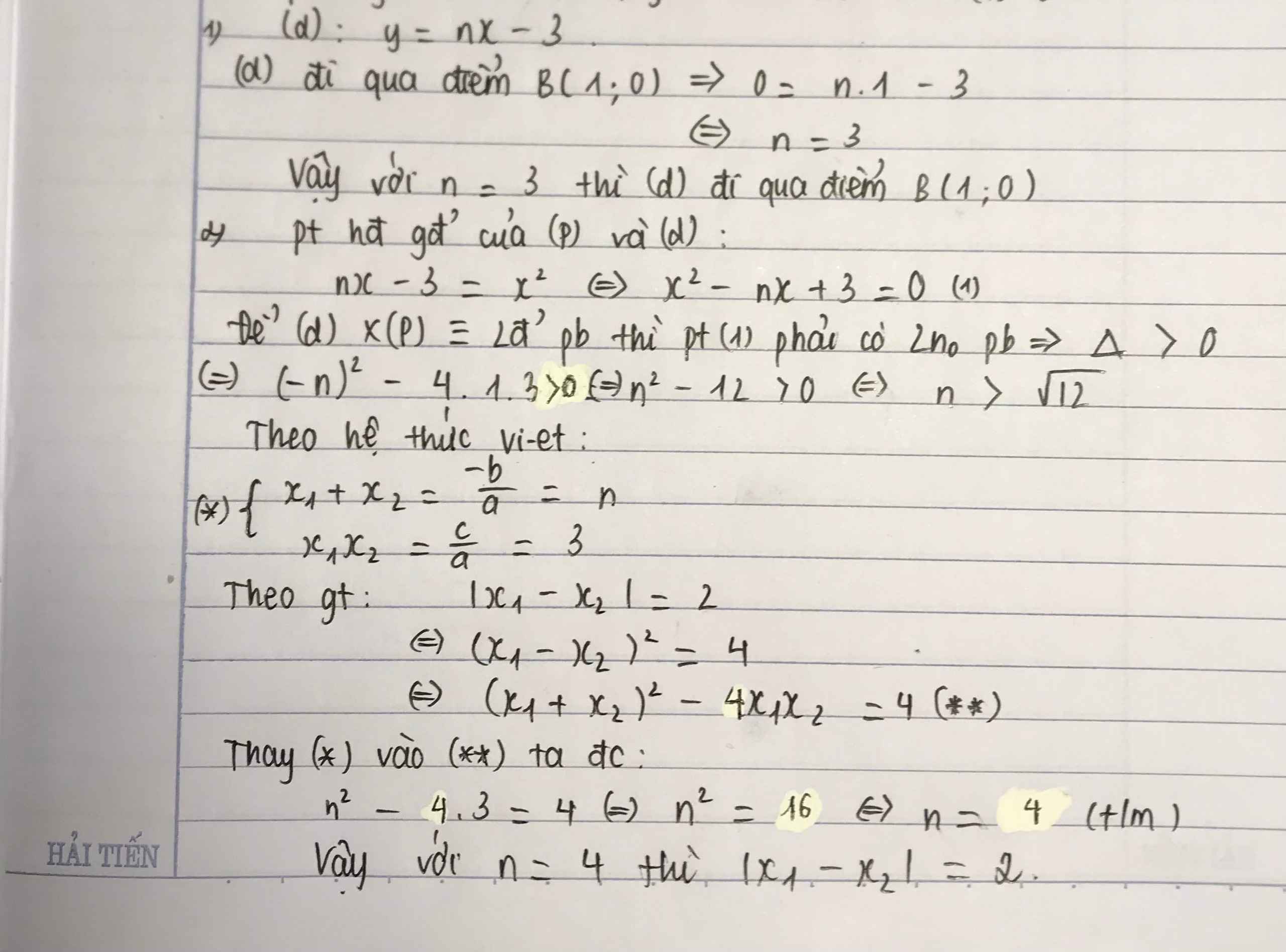Hãy nhập câu hỏi của bạn vào đây, nếu là tài khoản VIP, bạn sẽ được ưu tiên trả lời.

Phương trình hoành độ giao điểm là:
\(x^2-3x-m^2+1=0\)
\(a=1;b=-3;c=-m^2+1\)
\(\text{Δ}=9-4\cdot1\cdot\left(-m^2+1\right)\)
\(=9+4m^2-4=4m^2+5>0\)
Do đó: (P) luôn cắt (d) tại hai điểm phân biệt

PTHĐGĐ là:
x^2-(2m+1)x+m^2+m-6=0
Δ=(2m+1)^2-4(m^2+m-6)
=4m^2+4m+1-4m^2-4m+24
=25>0
=>Phương trình luôn có hai nghiệm phân biệt
\(\left|x_1^2-x_2^2\right|=50\)
\(\Leftrightarrow\left|\left(2m+1\right)\right|\cdot\sqrt{\left(2m+1\right)^2-4\left(m^2+m-6\right)}=50\)
\(\Leftrightarrow\left|2m+1\right|\cdot5=50\)
=>|2m+1|=10
=>m=9/2 hoặc m=-11/2

a, Thay m = -1/2 vào (d) ta được :
\(y=2x-2.\left(-\frac{1}{2}\right)+2\Rightarrow y=2x+3\)
Hoành độ giao điểm thỏa mãn phương trình
\(2x+3=x^2\Leftrightarrow x^2-2x-3=0\)
\(\Delta=4-4\left(-3\right)=4+12=16>0\)
\(x_1=\frac{2-4}{2}=-1;x_2=\frac{2+4}{2}=3\)
Vói x = -1 thì \(y=-2+3=1\)
Vớ x = 3 thì \(y=6+3=9\)
Vậy tọa độ giao điểm của 2 điểm là A ( -1 ; 1 ) ; B ( 3 ; 9 )
b, mình chưa học
\(y_1+y_2=4\left(x_1+x_2\right)\)
\(\Leftrightarrow x_1^2+x_2^2=4\left(x_1+x_2\right)\)(1)
Xét phương trình hoành độ giao điểm của (d) và (P) ta có:
\(x^2=2x-2m+2\)
\(\Leftrightarrow x^2-2x+2m-2=0\)
Theo hệ thức Vi-et ta có:
\(\hept{\begin{cases}x_1+x_2=2\\x_1x_2=2m-2\end{cases}}\)
Từ (1) \(\Leftrightarrow\left(x_1+x_2\right)^2-2x_1x_2=4\left(x_1+x_2\right)\)
\(\Leftrightarrow4-4m+4=8\)
\(\Leftrightarrow m=0\)
vậy..

a (tóm tắt lại): Phương trình hoành độ giao điểm của (P) và (d):
\(x^2=mx-m+1\)
\(\Leftrightarrow x^2-mx+m-1=0\left(1\right)\)
Để (d) cắt (P) tại 2 điểm phân biệt thì phương trình (1) phải có 2 nghiệm phân biệt. Do đó \(\Delta>0\Leftrightarrow m\ne2\).
b) \(\left(1\right)\Leftrightarrow\left(x-1\right)\left(x+1\right)-m\left(x-1\right)=0\)
\(\Leftrightarrow\left(x-1\right)\left(x-m+1\right)=0\)
\(\Leftrightarrow\left[{}\begin{matrix}x=1\\x=m-1\end{matrix}\right.\)
Do đó phương trình (1) có 2 nghiệm là x=1 và x=m-1. Mặt khác phương trình (1) cũng có 2 nghiệm phân biệt là x1, x2 và vai trò của x1, x2 trong biểu thức A là như nhau nên ta giả sử \(x_1=1;x_2=m-1\left(m\ne2\right)\)
Từ đây ta có:
\(A=\dfrac{2.1.\left(m-1\right)}{1^2+\left(m-1\right)^2+2\left[1+1.\left(m-1\right)\right]}\)
\(=\dfrac{2\left(m-1\right)}{1+\left(m-1\right)^2+2+2\left(m-1\right)}\)
\(=\dfrac{2\left(m-1\right)}{1+\left(m^2-2m+1\right)+2+2m-2}=2.\dfrac{m-1}{m^2+2}\)
\(\Rightarrow A\left(m^2+2\right)=2\left(m-1\right)\)
\(\Leftrightarrow Am^2-2m+2\left(A+1\right)=0\left(2\right)\)
Coi phương trình (2) là phương trình bậc 2 tham số A ẩn x, ta có:
\(\Delta'\left(2\right)=1^2-2A\left(A+1\right)=-2\left(A^2+A\right)+1=-2\left(A+\dfrac{1}{2}\right)^2+\dfrac{3}{2}\)
Để phương trình (2) có nghiệm thì \(\Delta'\left(2\right)\ge0\Rightarrow-2\left(A+\dfrac{1}{2}\right)^2+\dfrac{3}{2}\ge0\)
\(\Leftrightarrow\left(A+\dfrac{1}{2}\right)^2\le\dfrac{3}{4}\)
\(\Leftrightarrow-\dfrac{\sqrt{3}}{2}\le A+\dfrac{1}{2}\le\dfrac{\sqrt{3}}{2}\)
\(\Leftrightarrow-\dfrac{\sqrt{3}+1}{2}\le A\le\dfrac{\sqrt{3}-1}{2}\)
Để phương trình (2) có nghiệm kép thì: \(\Delta'\left(2\right)=0\Rightarrow m=\dfrac{1}{A}\)
\(MinA=-\dfrac{\sqrt{3}+1}{2}\Leftrightarrow\Delta'\left(2\right)=0\Leftrightarrow m=\dfrac{1}{A}\dfrac{1}{-\dfrac{\sqrt{3}+1}{2}}=1-\sqrt{3}\)
\(MaxA=\dfrac{\sqrt{3}-1}{2}\Leftrightarrow\Delta'\left(2\right)=0\Leftrightarrow m=\dfrac{1}{A}=\dfrac{1}{\dfrac{\sqrt{3}-1}{2}}=\sqrt{3}+1\)
Mình mới sửa một chút nhé.
\(\left(A+\dfrac{1}{2}\right)^2\le\dfrac{3}{4}\) \(\Leftrightarrow\left|A+\dfrac{1}{2}\right|\le\dfrac{\sqrt{3}}{2}\Leftrightarrow\left[{}\begin{matrix}A+\dfrac{1}{2}\le\dfrac{\sqrt{3}}{2}\\A+\dfrac{1}{2}\ge\dfrac{-\sqrt{3}}{2}\end{matrix}\right.\Leftrightarrow\dfrac{-\sqrt{3}}{2}\le A+\dfrac{1}{2}\le\dfrac{\sqrt{3}}{2}\)
Nếu gặp dạng \(a^2\le b\) (b là số dương) thì a sẽ bé hơn b và lớn hơn số đối của b, nói chung a nằm trong khoảng từ -b đến b.
Ví dụ: \(a^2\le4\Leftrightarrow\left|a\right|\le2\Leftrightarrow-2\le a\le2\)

Em kiểm tra lại đề, đề bài sai
Ví dụ với \(m=0\) thì (d) là \(y=2x-3\), khi đó pt hoành độ giao điểm (P) và (d) là \(x^2=2x-3\Leftrightarrow x^2-2x+3=0\) vô nghiệm nên (d) và (P) ko có điểm chung

Pt hoành độ giao điểm: \(x^2-mx-5=0\) (1)
Để (P) cắt d tại 2 điểm phân biệt \(\Leftrightarrow\left(1\right)\) có 2 nghiệm phân biệt
Do \(a.c=1.\left(-5\right)=-5< 0\Rightarrow\) pt luôn có 2 nghiệm pb trái dấu
Theo Viet: \(x_1+x_2=m\)
\(\left\{{}\begin{matrix}x_1>x_2\\\left|x_1\right|< \left|x_2\right|\end{matrix}\right.\) \(\Leftrightarrow\left\{{}\begin{matrix}x_1-x_2>0\\x_1^2< x_2^2\end{matrix}\right.\) \(\Leftrightarrow\left\{{}\begin{matrix}x_1-x_2>0\\\left(x_1-x_2\right)\left(x_1+x_2\right)< 0\end{matrix}\right.\)
\(\Rightarrow x_1+x_2< 0\Rightarrow m< 0\)
Vậy \(m< 0\) thì pt có 2 nghiệm thỏa mãn

